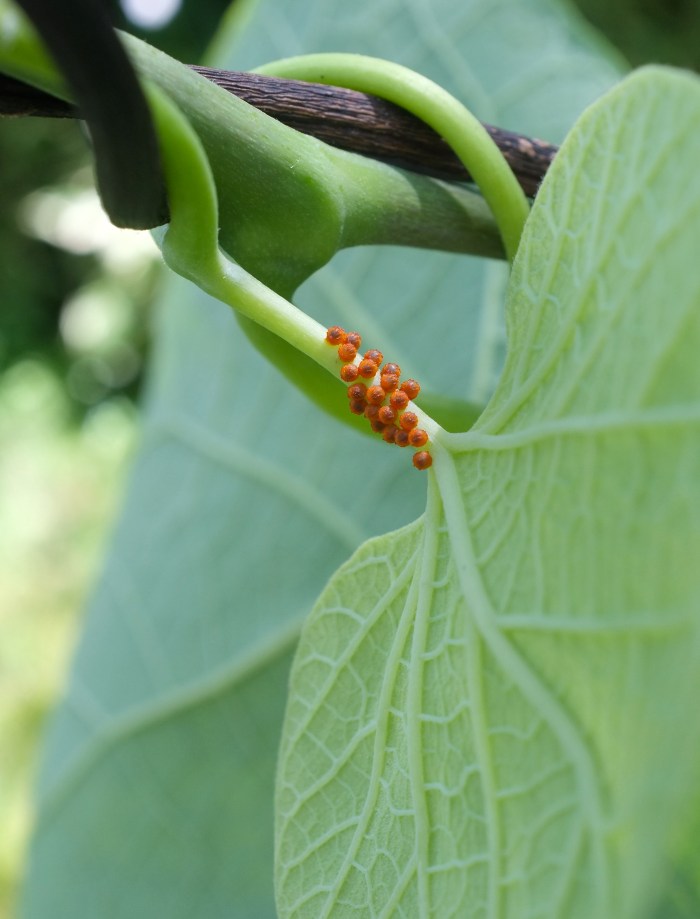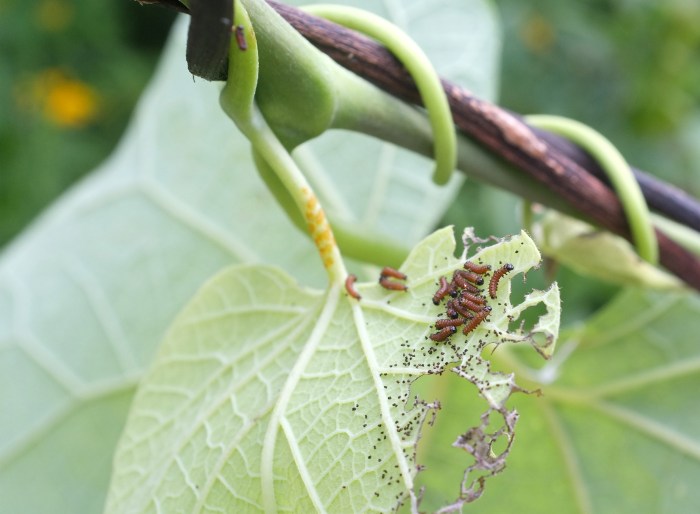Nearly five years ago in late September 2007, I photographed a male Pipevine Swallowtail Butterfly (Battus philenor) nectaring in my garden. I found mesmerizing its dark beauty, with black wings punctuated by brilliant orange spots and shimmering iridescence. The wings flashed electric blue in the fading late day sunlight and I became completely captivated!
![Battus philenor range map [Converted]](https://goodmorninggloucester.com/wp-content/uploads/2012/07/pipevine_rangemap_300px3.jpg?w=700) Range Map of Pipevine Swallowtail (Battus philenor)
Range Map of Pipevine Swallowtail (Battus philenor)
Although the Pipevine Swallowtail is not rare in its southern range, this exotic looking butterfly is quite an unusual occurrence in the northeast, and even more rarely found on the eastern outer reaches of Cape Ann. Mine was a stray, carried in on a southerly breeze. I imagined that if a male can drift into our garden, so can a female. And if a visiting female found in my garden her caterpillar food plant, she would deposit her eggs. The following spring we planted the Dutchman’s Pipevine (Aristolochia macrophylla). Four years later, and our pipevine has grown well. With emerald green enormous heart-shaped leaves, she is quite a showstopper clambering over the back fence. The plant is named for its flower, which resembles a Dutchman’s pipe, although when ours flowers, the blooms are so small, so few, and so lost in the foliage, I barely know when it is in bloom. Our pipevine took several years to become established, but once firmly rooted, it grew vigorously, but not invasively. At the end of the growing season, or the beginning of the next, I cut the vine hard, down to the ground. Dutchman’s Pipevine grows in full sun and partial shade and is hardy in zones 4 to 8.
Aristolochia macrophylla had its glory days in gardens during the two previous centuries, prior to the invention of air conditioning. It was planted to cover porches and treillage; cooling and shading the rooms within. When looking through old photos you can easily spot the porches and arbors that are embowered with pipevine because of the distinctive heart-shaped foliage. I imagine Fred Bodin may even have a few pictures of pipevine shrouded porches in his treasure trove of vintage photographs.
 Pipevine Swallowtail Egg Clutch
Pipevine Swallowtail Egg Clutch
About a week ago Saturday while doing chores in our backyard I noticed the rapid movements of a dark butterfly investigating the pipevine. I immediately paused because say, for example, if it was the more common Eastern Black Swallowtail, which deposits eggs only on members of the carrot family, it would not show the least bit of interest in the pipevine. Upon close investigation, it was a Pipevine Swallowtail and, without a doubt, it was a she! After first zooming in and out of the house to grab my camera, I observed her as she fluttered from tendril to tendril. She deliberately chose the tenderest leaves, pausing briefly several times to curl her abdomen to the underside to deposit her eggs. After she departed I ran in the house to tell anyone who would listen of the Great News. In our household my butterfly news is pretty much the family joke, although my husband kindly offered to get the tallest ladder from the basement. He held tight while I climbed to the top rung in search of eggs. I struck gold! Unlike the female Monarch and Eastern Black Swallowtail butterflies, which deposit eggs singularly, the Pipevine Swallowtail oviposits eggs in clusters. I counted somewhere between 25-30 eggs (very approximately) in the clutch we cut from the plant. I hope we have enough pipevine to feed this many hungry Pipevine Swallowtail caterpillars!
 Pipevine Swallowtail Caterpillars Several Hours Old
Pipevine Swallowtail Caterpillars Several Hours Old
 One Day Old Pipevine Swallowtail Caterpillars
One Day Old Pipevine Swallowtail Caterpillars
Map courtesy NABA

We’re right on the edge of their range, too. (Holland, Michigan) I wonder if we could get them if I planted Dutchman’s Pipevine. I’ve never seen any here.
LikeLike
Anne I would definitely give it a try!!! I don’t know where in relation to Holland, Michigan is Plymouth, but I recalled reading the following account on line:
From R. Smith, Plymouth, Michigan
Last year my friend and I attended a talk about “Butterfly Gardening.” The speaker mentioned the scarcity of Pipevine Swallowtails in Michigan lately and asked people to plant pipevines to try and help them out. Needless to say we both planted pipevines in our gardens.
It was a fascinating experience. We found eggs shortly before I was to leave on vacation. There were thriving caterpillars by the time we did leave…but boy did they eat! I had a neighbor caterpillar-sit (although she wasn’t too happy tending the little critters). Not wanting to be un-neighborly, she did not tell me of her apprehension at putting her hands in the aquarium. When we came back the first thing I did was race in to check on the Pipevines and was horrified at what I found. 4 large caterpillars had converged on a hanging chrysalis and had already eaten half of it. I was so upset I almost cried at the sight. After all my careful work nurturing them they had turned to cannibalism to survive. The aquarium I’d left with plenty of leaves held only stems’ and two withered green leaves. My friend had assumed that since they were green there was still food. Unfortunately the stems’ were lifted out of the water and they were no longer edible.
I quickly rushed to the pipevine plant outside and cut more leaves’ for them. Once the caterpillars found the fresh greens they did not seem to care about anything else. One by one they each formed a chrysalis and all went well. By this time it was nearly fall and we were hoping our butterflies would overwinter and wait until spring to emerge (since it had turned quite cold at night). They nevertheless started emerging. They were gorgeous! All our efforts had turned out the most beautiful butterflies you could want.
LikeLike
Very cool!!
LikeLike